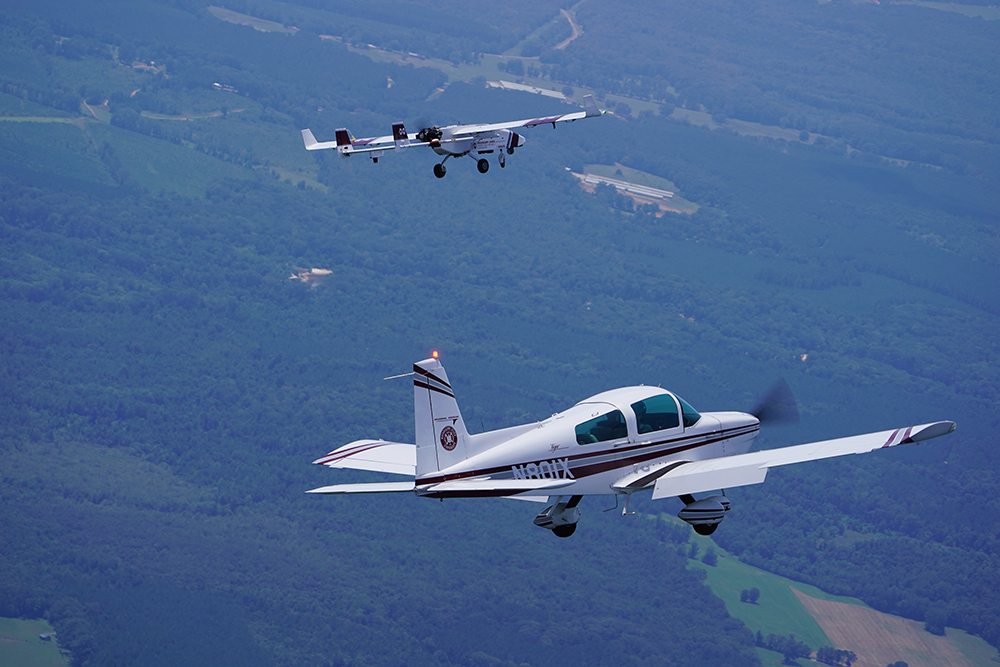News at the HPC²
River Mapping Advances Improvements in Flood Warnings and Mitigation
October 16, 2023
Raspet's TigerShark carries a complex camera payload as it flies above the Mississippi Pearl River in Leake County to capture images of its banks. Raspet's Tiger is operating as a chase aircraft for this UAS operation. (Photo by Nicole Thomas)
"Advanced modeling for river forecasting and flood mapping is critical to saving lives and protecting property," said Robert Moorhead, director of NGI and Mississippi State University (MSU) Geosystems Research Institute. The drone technology TigerShark, developed and operated by the Raspet Flight Research Laboratory at MSU, is a Group 3 uncrewed aircraft equipped with a complex camera payload. The U.S. Department of Defense classifies unmanned aerial systems (UAS) according to their size and capability.
"It is a pretty straightforward approach," said Jamie Dyer, associate director of NGI and professor of meteorology and climatology at MSU. "The high-resolution images provide a baseline and allow us to see where water exists and where it meets land. With that data, we can build a model to better predict how the water will move in a flood before it actually occurs."
This is welcome news to the nearly one million people who live along Mississippi's Pearl River, the second longest river in the state, that stretches more than 450 miles and covers almost two thirds of the state. Almost a year ago, residents of Jackson, MS began voluntary evacuations as the National Weather Service issued a flood warning for the Pearl River. Two years before, in 2020, the Pearl River reached its third highest crest in history, flooding hundreds of homes and businesses in Hinds and Rankin counties.
This summer, researchers flew the TigerShark along the banks of the Pearl River from Carthage to Jackson over two days in late July and early August to capture detailed imagery of where the water is and where it can go. The drone flights are the sixth in a series that began in 2018 as part of an ongoing research project led by NGI/MSU. As the TigerShark scanned 454 nautical miles of the Pearl River, Moorhead and Lee Hathcock, a data acquisitions coordinator for NGI, observed the UAS operation on display screens from inside Raspet's Ground Control Station, where images were delivered in real time.
"The better your models are, the better you can predict future floods," said Hathcock, who processes the images collected to generate updated maps for river forecasting. While it can be difficult, even dangerous, for researchers to access hard-to-reach areas of Mississippi's river systems, Raspet's experienced flight team combined with the largest, most capable UAS fleet in academic use, offers a safe, reliable alternative for data collection.
The first flight of the two-day exercise marked the second time for Raspet's TigerShark to fly at Mississippi's busiest airport – Jackson-Medgar Wiley Evers International Airport, taking off on the runway and sharing civilian airspace with traditional aircraft. For the second flight, the TigerShark flew out of Carthage-Leake County Airport, one of more than 40 cooperative airports across seven states that support Raspet's UAS operations.
"These flights further expand use of UAS and UAS technology as an important research tool while advancing UAS integration into the National Airspace System," said Raspet Director Rob Premo. "The project also demonstrates how MSU's research centers work together to leverage resources and create solutions to real-world challenges."
The Raspet Flight Research Laboratory is the nation's leading academic research center dedicated exclusively to the advancement of Uncrewed Aircraft Systems. Raspet is the only institute in the world designated both as the FAA's UAS Safety Research Facility and as official UAS Test Sites for both the FAA and the Department of Homeland Security, placing the research center at the helm of studying and developing UAS safety and certification standards. Home to a fleet of the largest and most capable unmanned aircraft in academic use, Raspet conducts UAS research on behalf of federal agencies and commercial industry partners, helping grow Mississippi's aerospace sector.
The Geosystems Research Institute is a collaborative of academic scientists, engineers, and government and industry stakeholders active in conducting research to advance knowledge and practice in Earth and its systems to improve policy and public awareness.
The Northern Gulf Institute is a NOAA Cooperative Institute with six academic institutions located across the U.S. Gulf Coast states, conducting research and outreach on the interconnections among Gulf of Mexico ecosystems for informed decision making.
This article was generated from a MSU press release MSU works toward better prediction of Pearl River flooding through drones and data-driven models.
